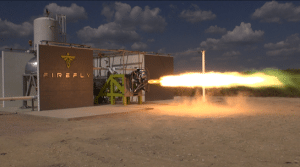Latest News
[Via Satellite 09-10-2015] Firefly Space Systems, designer of a series of dedicated launch vehicles for small satellites, today tested its first rocket engine Firefly Rocket Engine Research 1 (FRE-R1). The test took place at the recently completed 200 acre test facility in Briggs, Texas, located 25 miles from the company’s main engineering office in Cedar Park.
“The successful testing of our first engine represents a quantum step in the technical maturation of our company. We have demonstrated that our core engine design can reliably start, stop and operate at a steady state without combustion instabilities,” said Firefly Co-Founder and CEO Thomas Markusic.
Firefly is developing one combustor design for both stages of its first SmallSat launcher, Firefly Alpha. The Alpha upper stage will use an FRE-1 engine with a single combustor, whereas the first stage engine (FRE-2) will use an array of 12 of the same combustors arranged in an annular aerospike configuration.
FRE-R1 is a propulsion pathfinder for both stages of Alpha. It operates using LOx/RP-1 propellants, but the basic combustor design can use either methane or RP-1 fuels. The upper stage variant of the FRE-1 engine will produce 7,000 lbf thrust, and the first-stage cluster used in FRE-2 will produce 125,000 lbf thrust.
The test inaugurated Firefly’s new “Test Stand 1,” the first of several test stands for rocket engine, structural and stage system testing. Test Stand 1 is rated to handle more than 150,000 lbf of thrust, and its foundations extend 40 feet underground.
Upcoming engine tests will emphasize performance tuning and longer duration mission duty cycle runs. The first hot-fire tests of the FRE-2 aerospike engine are expected to take place in early 2016. Firefly is also considering the Briggs location for the site of its primary manufacturing facility, where the company plans to build up to 50 Alpha vehicles per year.
Get the latest Via Satellite news!
Subscribe Now